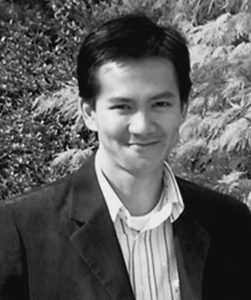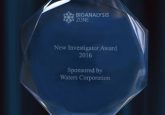2016 New Investigator: Cuong Cao

 Nominee:
Nominee:
Nominated By:
Supporting Comments:
What made you choose a career in bioanalysis?
When I selected my PhD project, my supervisor had given me three exciting topics to choose from: astaxanthin production from micro-algae, sludge treatment and biosensor development for disease diagnosis. Coming from a developing country where millions of people are living without or with very limited access to medical diagnostics and therapeutics, I realized that technologies allowing easy-to-use, low cost, rapid and reliable detection of diseases would be very important and useful for my country and other resource-poor settings. This has ignited me to opt for research in the field of biosensor development and thereafter it has shaped my research career in bioanalysis.
Describe the main highlights of your bioanalytical research, and its importance to the bioanalytical community.
My PhD thesis focused on the developments of plasmonic biosensors for sensitive and accurate detection of disease biomarkers and bacterial pathogens. These included the development of functional bionanostructures [1–4], the controlled synthesis of metallic nanoparticles [3,5] and the assay development [2,4,6–11]. I not only proposed an effective surface chemistry to avoid steric hindrance and maximize biological recognitions[1,6], but also introduced a productive enzymatic reaction to enhance the biosensing signal in a creative manner [7,8]. I built up a Rayleigh scattering microspectroscopy for the analysis of biological interactions using single gold nanoparticle as a nanosensor [10,11]. The system has greatly contributed to a number of important publications of my PhD supervisor’s group.
During my postdoctoral training I further expanded my research to the implementation of lab-on-a-chip technologies and molecular diagnostics for biological and chemical analyses [11–18]. I have also studied plasmonic metamaterials and other optically active nanostructures for the analysis of conformational change of nucleic acids, cancer diseases, mercury ions and plasticizers [19–24].
To date my research has contributed to the understanding of plasmonic nanomaterials, bringing attention of the bioanalytical community to the promising prospects of nanoplasmonics for bioanalytical applications, i.e. disease detection, food safety and food integrity, which present significant challenges to public health globally.
What is the impact of your work beyond your home laboratory?
Many of today’s technological and social challenges could be best resolved by multidisciplinary approaches. My research has been dedicated to bringing together elements from micro- and nanofabrication, applied physics, analytical chemistry and biology, which is truly multidisciplinary in nature. Throughout a number of years I have developed several proof-of-concept biosensor platforms that can be used for either fundamental biology research or applied bioanalysis. My publications have been frequently cited by many other research groups worldwide, and are of great interest to bioanalytical industry. We are currently collaborating with four industry partners in Northern Ireland (UK) to advance my research into a real-life analytical tool that allows detection and identification of infectious diseases and antimicrobial-resistant pathogens in ultra-sensitive, label-free, rapid and multiplexing manners. Through the industrial partnerships we aim to address the significant healthcare challenges and the huge societal demands for safer food.
Describe the most difficult challenge you have encountered in the laboratory and how you overcame it.
One of my projects was to develop a metamaterials-based biosensing platform to analyze both binding recognition and conformation of biomolecules. At that time, this project was quite challenging as it required multiple skill sets to be harnessed: top-down fabrication using electron-beam lithography, Raman and other spectroscopic analyses, theory simulation and biophysical techniques. The experiment outcomes were sometimes not what I expected because of mismatches between theory calculation and experimental observation. In the first two months I obtained almost no encouraging results. To overcome the difficult challenges, I used to break the problems down into different trackable elements, critically analyze the most possible causes, repeat and redesign the experiments to confirm my hypotheses, and find complementary expertise from my supervisors and colleagues. After constantly seeking expert advice and improving my fluency in the instrumentations, one day extremely exciting results were achieved. The results well-agreed with all theory calculations and helped me establish standard parameters for the entire device operation. Through this experience I have learnt that excitement and invention in research often lie in unexpected experimental results, they wait for us to uncover them if we are persistent enough and, most importantly, they shouldn’t be overlooked.
Describe your role in bioanalytical communities/groups.
Currently I am working as an academic member of the Institute for Global Food Security (IGFS), Queen’s University Belfast (UK). The mission of the IGFS is to nurture world’s leading scientists in food safety and to build a food-fortress, ensuring everything we import is of the highest quality and that what we sell locally and internationally is 100% safe, nutritious and authentic. At Queen’s, my scientific role is to promote the implementation of micro- and nanotechnologies for food safety analysis. I have also committed to teach and supervise students at undergraduate and postgraduate levels; and to contribute to other administration activities.
I have been frequently contributing to scholarly activities for the wider bioanalytical community. I have served as a reviewer for a range of scientific journals, am a member of scientific advisory board or organizing committee for several international conferences. Most notably, I was delighted to serve as a keynote speaker and a session chair at the Biosensors 2014 conference (Australia). The Biosensors conference is the world’s not only largest but also most prestigious forum in the bioanalytical fields. Through these activities, I could learn and benefit from the viewpoints of my fellows, widen my collaboration network and develop my scientific maturity.
Please list up to five of your publications in the field of bioanalysis:
- Cao C, Zhang J, Li S, Xiong QH. Intelligent and ultrasensitive analysis of mercury trace contaminants via plasmonic metamaterial-based surface-enhanced raman spectroscopy. Small 10, 3252–3256 (2014).
- Cao C, Zhang J, Wen X et al. Metamaterials-based label-free nanosensor for conformation and affinity biosensing. ACS Nano. 7, 7583-7591 (2013).
- Cao C, Gontard LC, Tram LLT, Wolff A, Bang DD. Dual enlargement of gold nanoparticles: from mechanism to scanometric detection of pathogenic bacteria. Small 7, 1701–1708 (2011).
- Cao C, Li X, Lee J, Sim SJ. Homogenous growth of gold nanocrystals for quantification of PSA protein biomarker. Biosens. Bioelectron. 24, 1292–1297 (2009).
- Cao C, Sim SJ. Resonant rayleigh light scattering response of individual Au nanoparticles to antigen-antibody interaction. Lab Chip 9, 1836–1839 (2009).
Please select one publication from above that best highlights your career to date in the field of bioanalysis and provide an explanation for your choice.
Cao C, Zhang J, Wen X et al. Metamaterials-based label-free nanosensor for conformation and affinity biosensing. ACS Nano. 7, 7583-7591 (2013).
In this study, we have shown for the first time that highly tunable plasmonic metamaterials can offer two transducing channels for parallel acquisition of optical transmission and fingerprinting spectra at the bio-interface, simultaneously probing the conformational states and binding affinity of biomolecules, e.g. G-quadruplexes, in different environments. We further demonstrated the use of the metamaterials for fingerprinting and detection of nucleolin, a cancer biomarker that specifically binds to the G-quadruplex, with the picomolar sensitivity. The novelty and significance of our work are highlighted in “Seeing Biomolecules in a New Light” by Christen Brownlee.
Find out more about this year’s New Investigator Award, the prize, the judging panel and the rest of our nominees.



